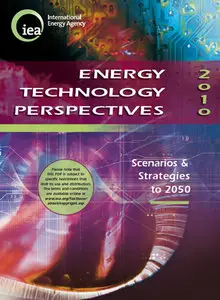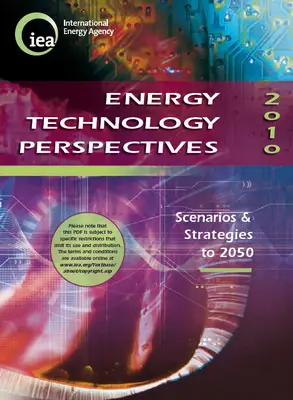Energy Technology Perspectives 2010: Scenarios & Strategies to 2050
IEA | 2010 | ISBN: 9264085971 9789264085978 | 710 pages | PDF | 11 MB
IEA | 2010 | ISBN: 9264085971 9789264085978 | 710 pages | PDF | 11 MB
This publication responds to the G8 call on the IEA to provide guidance for decision makers on how to bridge the gap between what is happening and what needs to be done in order to build a clean, clever and competitive energy future.
ETP2010 provides decision makers with more detailed practical information and tools that can help kick-start the transition to a more secure, sustainable and affordable energy future.
Brief CONTENTS
Introduction
PART 1 TECHNOLOGY AND THE GLOBAL ENERGY ECONOMY TO 2050
Overview of scenarios
Electricity generation
Electricity networks
Industry
Buildings
Transport
OECD Europe
United States
China
India
PART 2 THE TRANSITION FROM PRESENT TO 2050
Policies to accelerate a low-carbon technology transition
Technology roadmaps
Finance
Accelerating the diffusion of low-carbon technologies in emerging economies
Technology choices and behaviour
Environmental co-impacts of emerging energy technologies
Annexes
Contents
Foreword
Acknowledgements
Table of contents
List of figures
List of tables
List of boxes
Executive summary
Chapter Introduction
The political context
The purpose and scope of this study
PART 1 Technology and the Global Energy Economy to 2050
Chapter Overview of scenarios
Scenario characteristics
Energy and CO2 emission trends
Technologies for reducing CO2 emissions
Energy efficiency
Power sector
Fuel switching in end-use sectors
Carbon capture and storage
Investment costs and fuel savings
Regional and country-level trends
Sectoral trends
Energy trends
Coal
Liquid fuel
Natural gas
Biomass
Going beyond the BLUE scenarios
Chapter Electricity generation
Introduction
Recent trends
Generation mix by fuel
Efficiency of electricity generation
CO2 emissions
Future scenarios
Baseline scenario
BLUE Map scenario
BLUE scenario variants
Fossil fuel power plants
Overview
Technology status and prospects
Costs
Carbon capture and storage
Overview
Technology status and prospects
Costs
Renewable energy
Overview
Technology status and prospects
Costs
Nuclear power
Overview
Technology status and prospects
Costs
Chapter Electricity networks
Introduction
History of the grid
Electricity demand
Electricity demand by region
Electricity demand by sector
Demand profiles
Electricity generation
Power system fl exibility
Electricity network losses
Vision for the grid of the future
Smart grid technology
Benefits of smart grids
Smart grid CO2 emissions reduction
Benefits for developing countries
Storage technology
Analysis of electricity storage needs
How much does the grid of the future cost?
Barriers to electricity grid investment
Priorities for next steps
Regional assessment of grid needs
Technology research, development and demonstration (RD&D) needs
Markets
Regulatory and policy needs
Public education and public engagement
Human resources
Chapter Industry
Introduction
Industrial energy use and CO2 emissions
Energy and CO2 scenarios
Scenario assumptions
Scenario results
Carbon capture and storage
Industrial electrification
Recycling
Sectoral results
Current building stock and energy consumption
Households: the residential building stock and its characteristics
The service sector building stock
Global trends in buildings sector energy consumption
Residential sector
The service sector
Buildings sector CO2 emissions
Demand drivers in the scenario analysis
The Baseline scenario
Energy consumption by fuel and by sector
Energy consumption and CO2 emissions by region and by sector
The BLUE Map scenario
Energy consumption in the BLUE Map scenario
Investment requirements in the BLUE Map scenario
BLUE scenario variants
Technology options in the BLUE Map scenario
The building envelope and good design
Heat pumps for heating and cooling
Combined heat and power in buildings
Solar thermal heating and cooling
Lighting and appliances
Chapter Transport
Introduction
Energy efficiency by mode
Transport scenarios
Scenario results
Transport technologies and policies
Fuels
Light-duty vehicles
Advanced technology vehicles
Trucking and rail freight
Aviation
Shipping
Chapter OECD Europe
Regional description
Recent trends in energy and CO2 emissions
Energy production and supply
Energy consumption
End-use efficiency improvement
Carbon dioxide emissions
Overall energy policy framework
Current status of energy policies and climate change initiatives
Overview of scenarios and CO2 abatement options .
Energy and CO2 emission scenarios
Carbon dioxide abatement options
Sectoral results
Power sector
Industry sector
Buildings sector
Transport sector
Investment needs in the BLUE Map scenario
Transition to a low-carbon energy future
Future technology priorities
Future policy priorities
Chapter United States
Regional description
Recent trends in energy and CO2 emissions
Energy production and supply
Energy consumption
End-use efficiency improvement
Carbon dioxide emissions
Overall energy policy framework
Current status of energy policies and climate change initiatives
Overview of scenarios and CO2 abatement options .
Energy and CO2 emission scenarios
Carbon dioxide abatement options
Sectoral results
Power sector
Industry sector
Buildings sector
Transport sector
Investment needs in the BLUE Map scenario
Transition to a low-carbon energy future
Future technology priorities
Future policy priorities
Chapter China
Regional description
Recent trends in energy and CO2 emissions
Energy production and supply
Energy consumption
End-use efficiency improvement
Carbon dioxide emissions
Overall energy policy framework
Current status of energy policies and climate change initiatives
Overview of scenarios and CO2 abatement options
Energy and CO2 emission scenarios
Carbon dioxide abatement options
Sectoral results
Power sector
Industry sector
Buildings sector
Transport sector
Investment needs in the BLUE Map scenario
Transition to a low-carbon energy future
Future technology and policy priorities
Chapter India
Regional description
Recent trends in energy and CO2 emissions
Energy production and supply
Energy consumption
End-use efficiency improvement
Carbon dioxide emissions
Overall energy policy framework
Current status of energy policies and climate change initiatives 422
Overview of scenarios and CO2 abatement options .
Energy and CO2 emission scenarios
Carbon dioxide abatement options
Sectoral results
Power sector
Industry sector
Buildings sector
Transport sector
Investment needs in the BLUE Map scenario
Transition to a low-carbon energy future
PART 2 The Transition from Present to 2050
Chapter Policies to accelerate a low-carbon technology
transition
Introduction
The need for energy technology policies
Tailoring policies to the stage of technology development
Enabling actions: addressing the business and human aspects
of a low-carbon technology revolution
Energy technology research, development and demonstration
Current public-sector low-carbon RD&D expenditure
Private-sector RD&D spending
Assessing the gap: global low-carbon energy technology
RD&D needs
Accelerating energy technology RD&D
Chapter Technology roadmaps
A portfolio of technologies is needed
The role of roadmaps
Roadmaps
Roadmap summaries
Carbon capture and storage roadmap
Cement sector roadmap
Concentrating solar power roadmap
Electric and plug-in hybrid vehicles roadmap
Nuclear energy roadmap
Solar photovoltaic power roadmap
Wind energy roadmap
Chapter Finance
Investment needs
Baseline scenario
BLUE Map scenario
Fuel savings
Current trends in financing of low-carbon technologies and global energy asset finance
International financing mechanisms
Financing technology deployment in non-OECD countries
Financing options for an energy technology revolution .
Public finance mechanisms
Risk and returns
Cost of debt and equity
Risk versus return
Policy needs
A long-term integrated policy framework is needed
Financing renewables
Financing carbon capture and storage
Financing nuclear power
Financing low-carbon transport
Chapter Accelerating the diffusion of low-carbon technologies in emerging economies
Introduction
Background
Non-OECD countries’ contribution to CO2 emissions reduction in the Baseline and BLUE Map scenarios
Investment needs in emerging economies in the BLUE Map scenario 570
Diffusion of low-carbon technologies in emerging economies
Low-carbon technology fl ows
Trade fl ows
International financial fl ows of low-carbon energy technologies
Private fl ows
Official fl ows
Flows under the UNFCCC and the Kyoto Protocol
Summary of international financial fl ows for diffusion of low-carbon technologies
Enhancing technology diffusion
Strengthening low-carbon technological capacity in emerging economies
The way forward
Chapter Technology choices and behaviour
Introduction
The potential contribution of behaviour
Social and behavioural frameworks
Extensions and alternatives to the techno-economic model
Consumer adoption of energy-efficient technologies in households
Consumer adoption of low-carbon transportation
Purchase and adoption of more efficient light-duty vehicles
Reducing driving rebound effects
Modal shifts
Eco-driving via feedback and programmes
Policy implications
Chapter Environmental co-impacts of emerging energy technologies
Introduction
Objective and scope
Co-impacts in context
Impact areas
Co-impacts in the electricity sector
Technologies assessed
Baseline case: USC coal combustion
Biomass co-combustion
Carbon capture and storage
Integrated gasification combined cycle
Natural gas combined cycle
Nuclear: Generation-III
Solar: concentrating solar power
Solar: photovoltaic power
Wind
Quantitative results from the electricity sector
Overall results relative to the coal baseline
Transport co-impacts: passenger light-duty vehicles
Technologies assessed
Air impacts
Water impacts
Land impacts
Other considerations
Recommendations for next steps
Annex Framework assumptions
Annex IEA Energy Technology Collaboration Programme
Annex Acronyms
Annex Definitions, abbreviations and units
Annex References
with TOC BookMarkLinks



